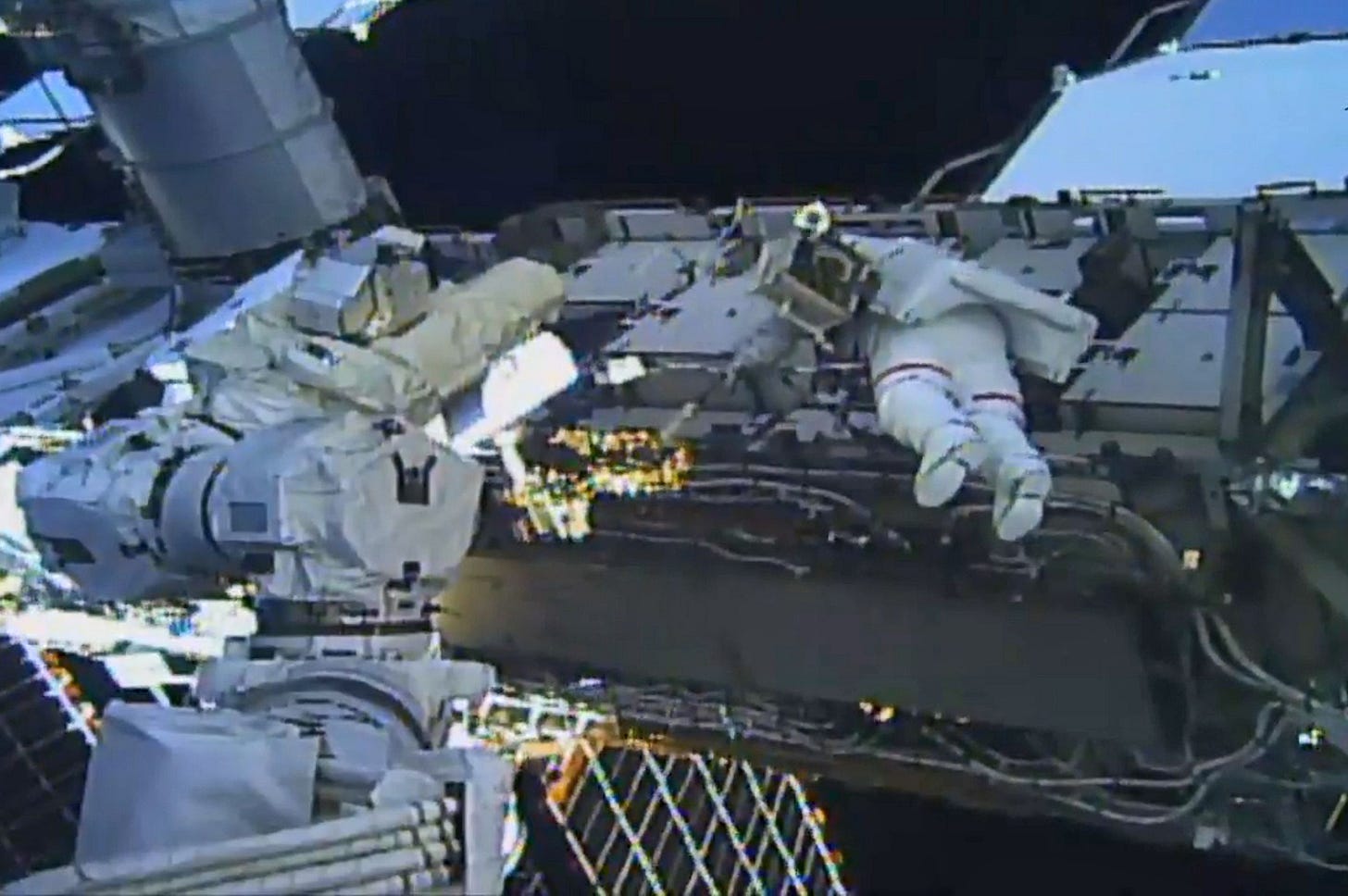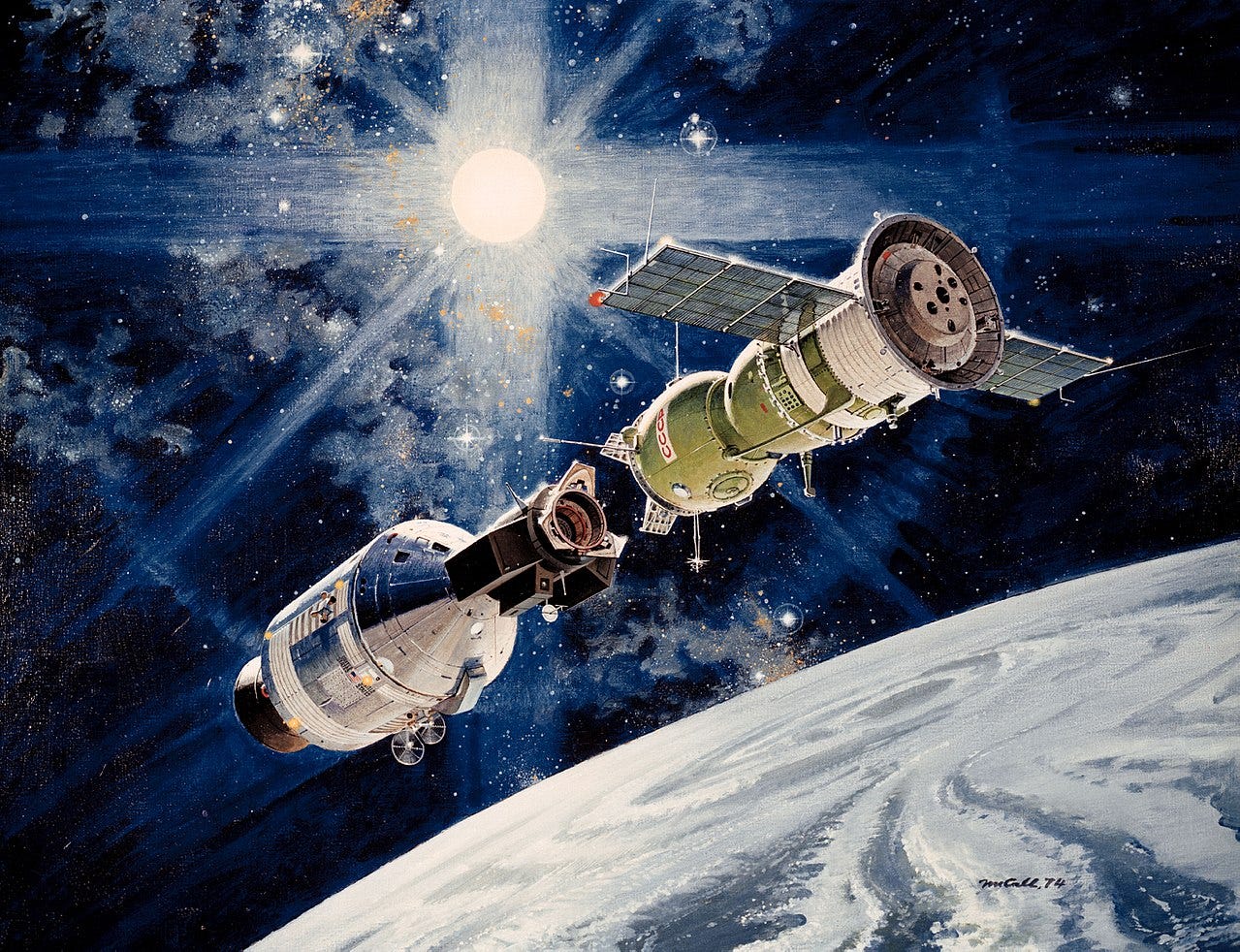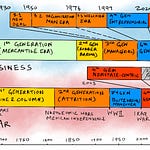Two things happened this week. Last Friday, Alexey Leonov, the first human to walk in space (in 1965), passed away. And this morning, Christina Koch and Jessica Meir went on the first all-women spacewalk on the ISS. So two historic events. And they got me thinking about the meaning of we in its most universalist, species-level sense.

Let’s take them in order.
Alexey Leonov was the first human to walk in space. He was also on the crew of one of the earliest experiments in international space cooperation, the Apollo-Soyuz Test Project, ASTP. So this was at the height of the Cold War.
Before we had the ISS, the ASTP mission was as close as humans have ever come to a Star Trek like Federation. In some ways, it was a more impressive technical, social and political achievement, since it was at the height of the Cold War, and the mission had to be designed around the existing US and Soviet programs, which used different designs, unlike the ISS, which was designed collaboratively by multiple nations.

As a kid, I owned a beautifully written and illustrated book by Leonov about ASTP (he was also an accomplished artist, if you google him, you’ll find a bunch of his paintings, including space paintings), and though this may sound cheesy, that book was probably one of the things that got me interested in space technology and end up going to graduate school for aerospace engineering, where I worked on space mission problems for my PhD.
I remember a drawing of the Apollo-Soyuz docking mechanism in particular in Leonov’s book, and wondering at the time about the general problem of linking two incompatible technologies, which I think is kinda really symbolic of the whole problem of species-level human coordination. I want to digress a bit to talk about that.
If you’re an engineer you know this: in any design, any time two parts come together to form a coupling, they tend to be designed asymmetrically, because that tends to be the easiest way. So one part gets designated male and the other part female, and the logic is the logic you would expect. It’s one of the rare funny bits of sexual logic in the generally sexless world of engineering jargon.
Later, as an adult, long after I read Leonov’s book, I heard this story (I don’t know how true it is) that one of the bones of contention — which Leonov didn’t talk about in his book — was making sure the docking system design was symmetrical, in the form of what is known as an androgynous coupling, because neither side wanted to be the “female” side. Apparently the nickname of the system was “androgynous brothers”, which I find hilarious. The official justification was of course, more technical: that with an androgynous coupling, either side could play the active or passive role, and that would make for greater mission flexibility and system-level redundancy. But I kinda buy the theory that the system ended up ungendered for less technical reasons. It sorta makes sense for that era of technology.
You could say ASTP was consciously designed to not just be a showcase of global cooperation, briefly forgetting the divide between the two sides of the Cold War. It also ended up being unintentionally gender-neutral for what were perhaps the wrong reasons. Long before we had culture wars about gender-neutral bathrooms here on earth.
And speaking of gender and space, that brings us to the second historic event of the week.
This morning, I just happened to catch a retweet of the NASA live feed of the space walk. I had no idea it was going on, but I am always willing to interrupt whatever I’m doing to watch space stuff. So I started watching, and I found myself drawn to the very basic shared human things that space forces us to grapple with. For example, I found myself noting and counting the orientation words the astronauts were using, like up, down, aft, fore etc and wondering about how humans think and talk about orientation in microgravity, where there is no natural direction of up, which is of course one of the most basic shared human things, a shared sense of which way is up.
At the back of my mind I was also wondering if women coordinate and communicate any differently on complex tasks than men. The ground control person was also a woman, so the entire audio-track for the live broadcast was female, which was interesting. But the gender aspect was less interesting to me than the basic human aspect. Here we are, as bodies in space, being governed by the laws of classical physics. Inertia, movement, velocities, accelerations. That was the more interesting part.
In fact, I didn’t realize till later, when I read up on the event, that it was a historic all-women spacewalk that had to be canceled once before because they didn’t have two spacesuits of the right size.
Anyhow, the two events together got me thinking about our sense of collective nouns like “us” and “we” and how in everyday life, they tend to factor across obvious tribal, gender, or other sorts of identity faultlines. Sometimes, it can seem like there is no such thing as a shared “we” that applies to humanity as a whole.
In my more cynical moments, I tend to think that every use of the word “we” is a disingenuous attempt to humanize some people at the expense of others. My line about this is a version of the principle: you cut the cake, I’ll pick the bigger half. The identitarian version is: you decide what rights are basic human rights, I’ll decide who counts as human. Which is the version that has historically been the most common one practiced. When people say “we the people,” they typically mean a particular subset of people counting as human.
Space missions are a reminder that there is substance to both the differences and commonalities that make us human.
On the one hand, space missions reinforce the sense of idealism that yes, there is in fact such a thing as a non-vacuous universal “we” that includes all humans, and perhaps all living things. When any human does something interesting in space, we all participate in the moment. When I logged on this morning, there were 14,000 viewers of the live feed. That’s fascinating. Honestly, I’d be very interested in seeing the demographic breakdown of that audience.
When any human does something in space, what they do is human at a very basic level: they move, they breathe air, the grip things, they communicate. All the trivial unconscious shared humanity, including a sense of up, that we forget here on earth, becomes a very live concern in space. So yeah, the idealism has substance.
Hell, even a dog or monkey in space evokes identification.
Recently, a Chinese lunar lander recently even grew a sapling on the Moon, and frankly, I identify with that sapling too. Life in space is a very powerful reminder of how much all of life has in common. Yes, there is a Hobbesian struggle of nature-red-in-tooth-and-claw aspect, so there is that aspect of nature as well, but it is amazing how much life has in common.
But on the other hand, space is also a reminder that we can’t pretend identity issues are entirely made-up political bullshit.
We’ve had a complex bit of space technology, the ASTP docking system, possibly designed a certain way because of gender sensitivities. We apparently had the first all-female spacewalk delayed because they didn’t have two suits in the right size. And these are not cosmetic matters. It’s not all virtue signaling or identity signaling. Matters of life and death hinge on things like spacesuits being the right size. The live video showed this starkly: periodically the ground controller would ask the astronauts for suit checks. So, it’s real life-and-death stuff.
So yeah, space missions show us that both our differences and commonalities have deep substance to them.
But overall, the moral of the story of space exploration as revealed by the events of this week, reflecting on the life of Alexey Leonov, ASTP and the historic event of the first all-woman spacewalk, is a pretty uplifting one.
It’s hard, but we don’t have to choose between immutably essentialized identities on the one hand, and universalist tendencies to identity with all life on the other. Our differences and similarities are both real, and they both matter, and we — and I do mean we as a species now — we have to learn to accommodate both in our collectivist tendencies. They both matter, differences and commonalities.
And to bring this back to earth from space, when we think about this in terms of all the things that absorb us here on earth everyday as part of the culture wars, and the news headlines. And you make that seemingly sophisticated argument, whenever somebody says we must do this, we must combat climate change, we must combat sexism, we must not let identity and political correctness destroy things. Whichever side you’re on, there’s a lot of we and us words being used in conversation, and most of the time, they indicate we’s and us’es that are less than universal, and we all recognize that, and sometimes we call each other out on it.
Like one of the most common sophomoric debate tactics is, when an opponent says something like we must do X, you challenge them on what we are we talking about here. Even though this is a tactic you learn in college, it is important to call out, and force people to define and defend the level of collectivism at which they think good things are good and evil things are evil.
You kinda have to make people take ownership of their we’s and us’es.
So that’s the reflection of the week on the lessons of space walks and historic space events here on earth. If you didn’t know any of this history, I recommend taking 15 minutes to google and learn about it. It’s fascinating stuff, especially the ASTP mission.












Spacewalks and the Species